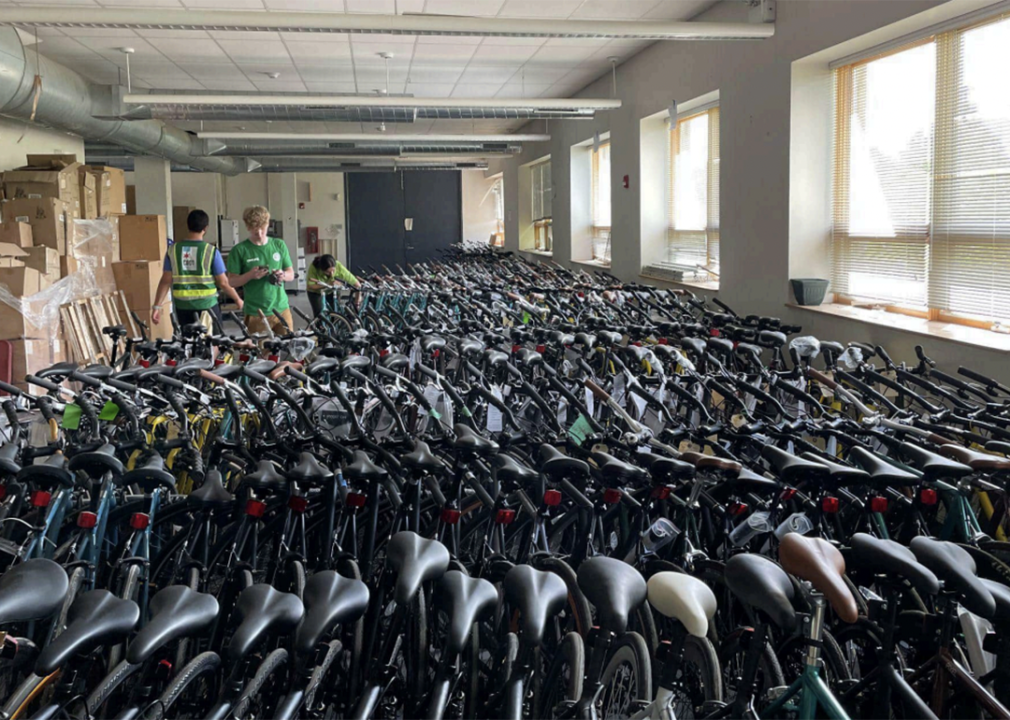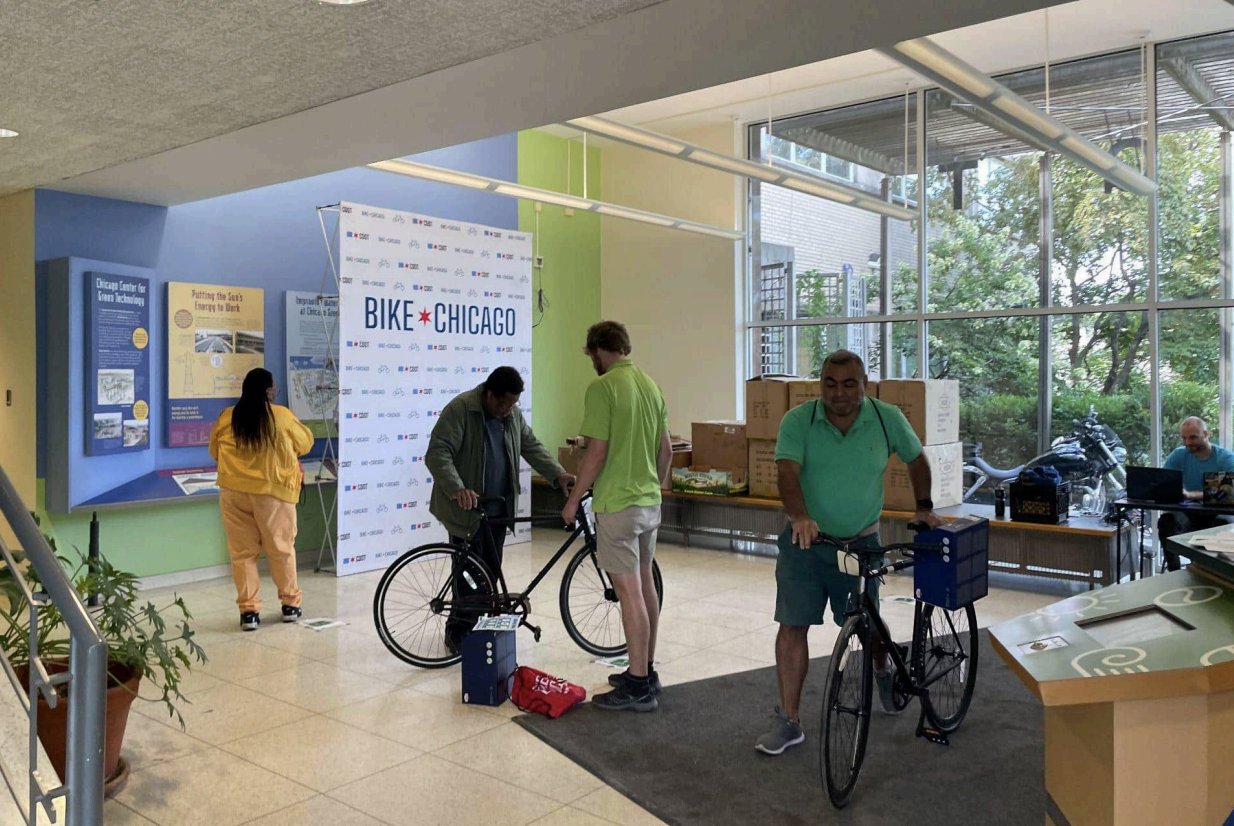One city's unique bike giveaway program is a win for mobility justice
Next City reports that by giving free bikes to those most in need, the Bike Chicago program has proven a powerful strategy to grow active transportation.

When the Chicago Department of Transportation (CDOT) launched its Bike Chicago program in the summer of 2022, the city began working on its goal to promote active transportation and target "mobility hardship" by injecting working-class communities with free access to cycling.
Now, a report on the first two years of the country's biggest free bike distribution program says it's proven an "effective, cost-efficient model for getting bicycles into users' hands for transportation" in disinvested neighborhoods.
"First and foremost, it's an incredible program," says Pete Lauer, program manager at the nonprofit Shared-Use Mobility Center (SUMC), which promotes equitable and ecological alternatives to car-centric transport.
Next City reports that CDOT has distributed over 2,000 single-speed, pedal bicycles out of its goal of 5,000 and is expected to continue through 2026. It pairs these with bike security, safety equipment and optional maintenance classes.
In total, the program cost the city about $652 per distributed bicycle. After the giveaway, about 28% of survey respondents said they rode their bike three to five times weekly, and about 12% said they ride near daily.
The analysis comes as new data from a CDOT study shows that bike ridership in Chicago has grown by 119% over the last four years, the largest such spike among America's 10 biggest cities. Some of the largest increases happened in Chicago's South Side, in neighborhoods including Kenwood and Englewood.
The biggest free bike distribution program in the U.S.

Bike Chicago is notably larger than other physical bike giveaway programs across the country, of which there have been few. SUMC reports that similar programs in West Hollywood, New York City, and Charlotte have each distributed between 50-200 bikes.
Much more common are e-bike voucher programs, which fund part of the cost of an e-bike. One of the largest is operating in Denver, through which over 6,000 vouchers of either $400 or $1,200 have been distributed. Depending on the cost of the bike, this can still leave a recipient paying hundreds or even thousands of dollars for mobility access.
"It's very easy, in transportation, to be caught up with tech-based solutions," Lauer says. "In a city like Chicago, the answer doesn't need to be e-bikes. The answer doesn't need to be a new-tech solution. A standard single-speed bicycle is a great solution for many able-bodied Chicagoans."
Among other benefits, standard bicycles are often much cheaper than e-bikes. SUMC reports that Bike Chicago has run at a cost of $652 per bicycle, which includes the materials themselves, labor, and distribution costs.
In order to operate on such an unprecedented scale, CDOT has also made the Bike Chicago distribution process incredibly efficient. In around 30 minutes at a pickup facility, recipients go through a safe riding webinar, are fitted for a helmet, and claim their bike and equipment.
Despite its efficiency and scale, the demand for mobility far exceeds what is feasible for Bike Chicago. CDOT reports that during the summer of 2022 alone, over 19,000 applications were submitted. Recipients over the past 2 years have been selected from this 2022 pool.
To ensure that these limited resources are reaching individuals with the most need, the city has been using the Mobility and Economic Hardship Index. Developed by the Center for Neighborhood Technology, the index combines metrics for transportation infrastructure and economic hardship and gives each neighborhood a score out of 100.
The adoption of this index means that, ideally, Chicagoans at the intersection of inadequate mobility access and severe poverty are the first to receive bikes.
Beyond carefully considering who is in the most need of mobility resources, initiatives like Bike Chicago must consider bike-friendly urban design, researchers say. This consideration must go in two directions.
Developing cycling infrastructure in communities without easy access to bicycles runs the risk of creating an alienating bike culture. "You don't want people to see their neighborhood as a throughway for other neighborhoods which are more typically served by infrastructure services," Lauer says.
As such, overlooking existing mobility access when developing bike-friendly infrastructure in under-resourced neighborhoods may, ironically, only expand the resources of already privileged communities.
Inversely, handing out bicycle equipment to communities which lack safe cycling infrastructure can impede the effective use of these limited resources. In SUMC's post-giveaway survey to Bike Chicago recipients, almost half of the respondents reported that "not enough safe bike routes" prevented them from using their bike more often.
Safe and inviting cycling infrastructure must extend beyond paving and painting concrete paths, Lauer notes.
"There are all these other services in addition to roads and bridges and highways that make you feel safe driving in your car," he says. Services like roadside assistance, which yet come at a cost and steepen the financial barrier to mobility, provide commuters with assurance beyond physical construction that they are safe and protected. Low-cost options like cycling often lack similar infrastructure.
One remedy Lauer suggests is public park vending machines.
"In addition to all the bike shops around the city, what if people in parks or schools had easy access to patch kits and tubes, multi-tools, things like that, that help people to use their bike to get home?"
He also urged the city of Chicago to reopen the McDonald's Cycle Center in Millenium Park. Initially opened in 2004, it was pivotal to the growth of Chicago's bike culture, providing cyclists with lockers, showers, parking, repairs and bike rental. The center ceased operations indefinitely in 2022 and has not yet resumed.
Another improvement Lauer suggests is the inclusion of local bike shops in the distribution. He believes it would both help connect municipal funds to small businesses and expand the diversity of resources that Bike Chicago recipients may receive.
"That's something that we would hope to promote in the future," he says. "A deeper connection to these existing businesses and the services they offer."
This story was produced by Next City, a nonprofit newsroom covering solutions for equitable cities, and reviewed and distributed by Stacker Media.
Comments





